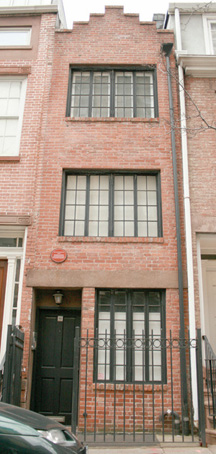

Andrea Barnet's List of Bohemian Hang Outs
Can you identify what is now at these addresses? Help us match these old hang outs with their modern counterparts!
If you have any stories, memories or historical factoids to share about these locations, as well as information about their current occupants, please e-mail us!

Claire Marie Press, 3 East 14th, (1913-14) Run by poet Donald Evans and best known for publishing Tender Buttons by Gertrude Stein.
Club A. 3 5th Ave. Cooperative lodging for writers, including Jack London, Upton Sinclair, Mark Twain, Mary Heaton Vorse.
The Hell Hole-(also known as the Golden Swan) seedy Irish bar at the corner of 6th and 4th St. Hangout of Dorothy Day, Charles Demuth, Eugene O'Neill. The proprietor kept a pig in the cellar and fed it scraps from the free-lunch counter. According to Malcolm Cowley, 'The boys in the back room were small-time gamblers and petty thieves, but the saloon was also patronized by actors and writers from the Provincetown Playhouse, which was just around the corner... The Hell Hole stayed in business for first two years of prohibition, but then it was closed... The actors and playwrights moved on to…
The Working Girl's Home,” (also known as Luke O'Connors)- seedy bar at corner Christopher and Greenwich Ave.
Washington Square Bookshop. 135 MacDougal St. (1913-14) Became an informal lending library and site of Liberal Club plays. Moved to 27 West 8th in 1915.
Washington Square Gallery. 47 Washington Square South. (1914-16) Run by Robert Coady, editor of Soil, it showed European modernist art
Pen and Brush Club.16 east 10th St. arts organization headed by ida Tarbell.
Gonfarones. 179 MacDougal St. from early 1900's on, “ a resort of scribes, artists, cranks and lovers.” (Albert Parry, Garrets and Pretenders)
Hotel Brevoort- Fifth Ave and 8th St. on Northeast corner.-restaurant frequented by all the Village artists and writers. It had a basement café featuring small rooms with mirrored partitions and marble-topped tables. Everyone from Emma Goldman to Djuna Barnes, Edna St. Vincent Millay, Isadora Duncan, Mable Dodge, John Reed, Max Eastman, Mina Loy went there.
Hotel Lafayette. University Place and 9th St. like the Brevoort
The Liberal Club. 137 MacDougal St. (1913-1918)
Polly's Restaurant. The basement of 137 MacDougal St.(between W. 4th and 3rd.) 1913-1915.( Upstairs was the Liberal Club.)
147 W. 4th. (1915-17) Polly's second restaurant. Later became the Whitney Studio Club. John Reed rented a room for writing at this site.
5 Sheridan Sq. Polly's third restaurant (after 1917) expanded to include 2 dining rooms and a basement grill. More commercial.
Provincetown Players. 139 MacDougal St. parlor floor. (1916-17) next door to Polly's. First N.Y. site. Moved to 133 MacDougal and stayed for next 10 yrs.
Webster Hall. 119 E. 11th St. (thru 1910's) scene of Village Artist's balls, including the Blind Man's Ball, Anarchist Ball
The Dial Magazine. 152 W. 13th St. (1918-1929) editorial offices of magazine. Marianne Moore was its editor from 1920-1929.
Dutch Oven. 137 MacDougal. Served lunch, tea and dinner. Took over Polly's space.
The Little Review, one of the leading avant garde magazines of the day, editorial offices at 31 W. 14th St. basement apartment. (1916-1920)
Mad Hatter. 150 W. 4th St. Greenwich Village's first tea room. Run by Edith Unger.
My Tea Wagon. 118 Washington Place (from 1917) Tearoom decorated in orange and black.
Romany Marie's. S.E. corner Thompson and Washington Sq. S. Teahouse frequented by bohemian Greenwich Village in 1910's.
Open Door. 134 W. 4th. (from 1917) restaurant advertised “Come Dance and Be Merry in Bohemia”
The Crumperie. 6 Sheridan Square. (1917-19) tearoom
The Dutch Oven. 137 MacDougal St. (1916-19) Served lunch, tea, and dinner. It took over the space occupied by Polly's.
Greenwich Village Theater. 3 Sheridan Square. (1917-30) First posh theater in Village, it attracted uptowners. Staged plays by Sinclair Lewis, O'Neill and others.
Purple Pup. 38 Washington Sq. West (from 1917) tearoom and restaurant.
Samorvar. 148 E. 4th St. site of many Provincetown Player's meetings
Washington Sq. Bookstore. 27 W. 8th St. (from 1915)
The Masses magazine. Offices. 91 Greenwich Ave. (June 1913-Dec. 1917)
Mother Bertolotti's. 85 West 3rd St. (1910-1917) A family restaurant with 15 cent spaghetti and red wine.
“Sixty” 60 Washington Square South (1915-16) popular restaurant run by Polly Holladay's brother, bankrolled by his lover Louise Norton.
Strunsky Restaurants, 19 W. 8th Street (from 1917) three restaurants in one. On the first floor was Washington Square Restaurant, on the lower floor was Washington Square Cafeteria and Greenwich Village Cafeteria. (Also known as “Three Steps Down”)
Thimble Theater. 10 5th Avenue. (1915-16) phonograph concerts and plays.
Tiny Tim- 6th Ave at Milligan Place.(1916-1918) Candy store
John Squarcialupis restaurant. Speakeasy at 30 Perry St., Frequented by Edmund Wilson and friends
Grand Ticino Restaurant. MacDougal St. spot where Edna often wrote in the afternoons.
The Liberator magazine. 138 W. 13th St. Max Eastman started magazine. Published writing by Edna St. Vincent Millay, William Carlos Williams, Elinor Wylie, e.e. cummings.
Quill. 133 Washington Place. (1917-29) monthly publication that popularized Village.
Bruno's Garret. 58 Washington Square S. (1914-16) run by Guido Bruno. In 1916 became the site of a bohemian restaurant run by Romany Marie. After she moved on it became a spaghetti restaurant called Grace Godwin's Garret. (1917)

Sources:
Strange Bedfellows: The First American Avant-Garde. By Steven Watson. Abbeville Press
All-Night Party: The Women of Bohemian Greenwich Village and Harlem; 1913-1930. By Andrea Barnet. Algonquin Press. A division of Workman Publishing.
|
 |